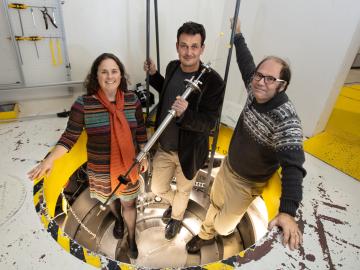
Filter News
Area of Research
- (-) Materials (59)
- (-) Neutron Science (14)
- (-) Supercomputing (51)
- Advanced Manufacturing (14)
- Biology and Environment (21)
- Building Technologies (1)
- Computational Biology (1)
- Computational Engineering (1)
- Computer Science (5)
- Electricity and Smart Grid (2)
- Energy Science (86)
- Fusion and Fission (5)
- Fusion Energy (3)
- Isotopes (1)
- Materials for Computing (10)
- National Security (13)
- Nuclear Science and Technology (4)
- Quantum information Science (1)
- Sensors and Controls (1)
- Transportation Systems (1)
News Type
News Topics
- (-) 3-D Printing/Advanced Manufacturing (13)
- (-) Big Data (20)
- (-) Grid (3)
- (-) Materials Science (48)
- (-) Physics (17)
- (-) Summit (28)
- Advanced Reactors (3)
- Artificial Intelligence (25)
- Bioenergy (10)
- Biology (9)
- Biomedical (22)
- Biotechnology (1)
- Buildings (4)
- Chemical Sciences (14)
- Clean Water (4)
- Composites (6)
- Computer Science (66)
- Coronavirus (12)
- Critical Materials (7)
- Cybersecurity (2)
- Energy Storage (19)
- Environment (26)
- Exascale Computing (17)
- Fossil Energy (1)
- Frontier (18)
- Fusion (6)
- High-Performance Computing (28)
- Hydropower (1)
- Isotopes (9)
- Machine Learning (11)
- Materials (39)
- Mathematics (2)
- Microscopy (15)
- Molten Salt (1)
- Nanotechnology (21)
- National Security (3)
- Neutron Science (84)
- Nuclear Energy (17)
- Partnerships (3)
- Polymers (13)
- Quantum Computing (16)
- Quantum Science (16)
- Security (3)
- Simulation (13)
- Software (1)
- Space Exploration (6)
- Transportation (17)
Media Contacts

The prospect of simulating a fusion plasma is a step closer to reality thanks to a new computational tool developed by scientists in fusion physics, computer science and mathematics at ORNL.

The formation of lithium dendrites is still a mystery, but materials engineers study the conditions that enable dendrites and how to stop them.

Scientists at have experimentally demonstrated a novel cryogenic, or low temperature, memory cell circuit design based on coupled arrays of Josephson junctions, a technology that may be faster and more energy efficient than existing memory devices.

Researchers across the scientific spectrum crave data, as it is essential to understanding the natural world and, by extension, accelerating scientific progress.

For nearly three decades, scientists and engineers across the globe have worked on the Square Kilometre Array (SKA), a project focused on designing and building the world’s largest radio telescope. Although the SKA will collect enormous amounts of precise astronomical data in record time, scientific breakthroughs will only be possible with systems able to efficiently process that data.

Researchers at Oak Ridge National Laboratory demonstrated that an additively manufactured polymer layer, when applied to carbon fiber reinforced plastic, or CFRP, can serve as an effective protector against aircraft lightning strikes.

Scientists at the U.S. Department of Energy’s Brookhaven National Laboratory have new experimental evidence and a predictive theory that solves a long-standing materials science mystery: why certain crystalline materials shrink when heated.

The type of vehicle that will carry people to the Red Planet is shaping up to be “like a two-story house you’re trying to land on another planet.

In collaboration with the Department of Veterans Affairs, a team at Oak Ridge National Laboratory has expanded a VA-developed predictive computing model to identify veterans at risk of suicide and sped it up to run 300 times faster, a gain that could profoundly affect the VA’s ability to reach susceptible veterans quickly.

Researchers at Oak Ridge National Laboratory proved that a certain class of ionic liquids, when mixed with commercially available oils, can make gears run more efficiently with less noise and better durability.


